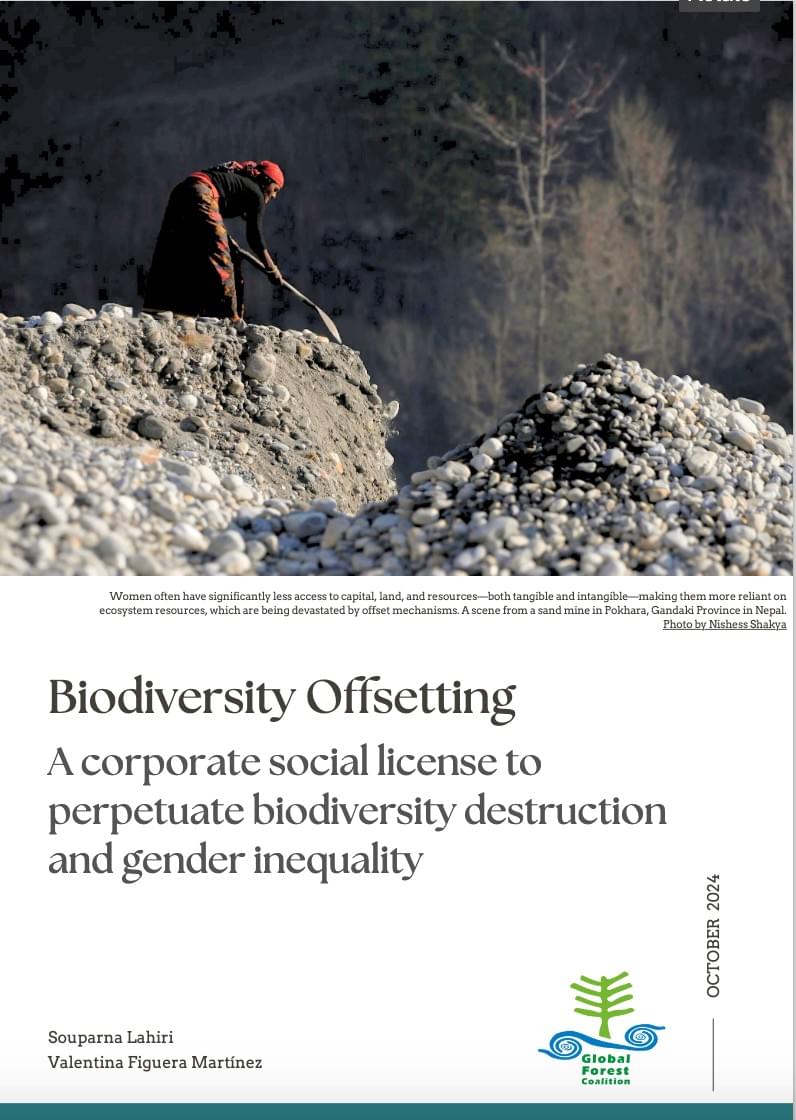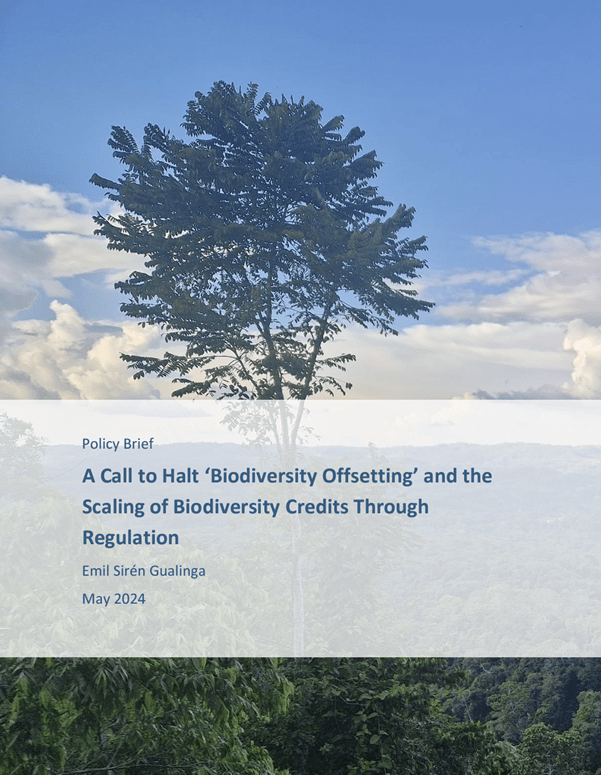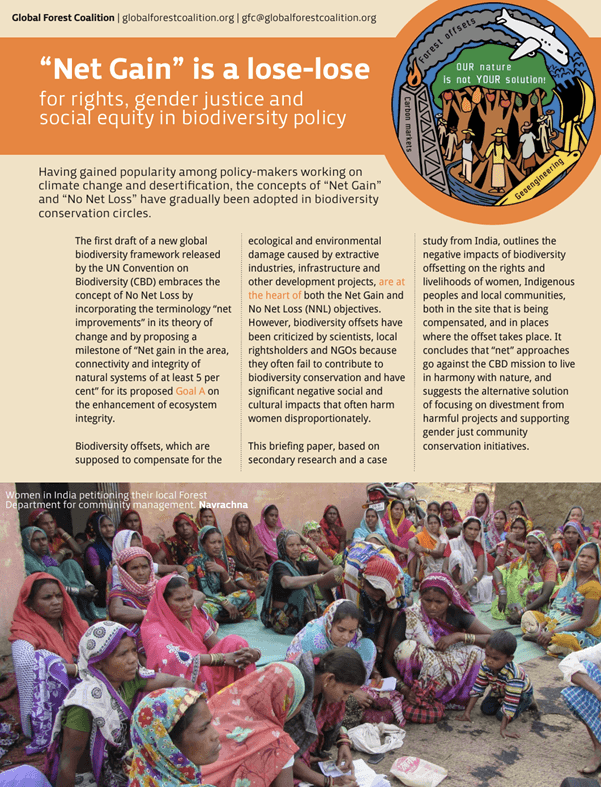biodmarketwatch.info
RESEARCH & ANALYSIS PARPERS

The Biodiversity Market Mirage (Oct 2024)
Biodiversity is in crisis. Nature is being degraded and destroyed at a dizzying pace, and entire species are being eradicated as their habitats disappear. Over the past years, the obvious solution to stop destroying ecosystems and uphold the Rights of Indigenous Peoples has been overshadowed by various ploys to quantify and put a financial value on nature. In this report, presented at the opening of the UN Convention on Biological Diversity COP16 in Cali, Colombia, we take a closer look at biodiversity offsets and credits, which are part of the plethora of market-based schemes that are being presented as antidotes to the biodiversity crisis. Biodiversity offsets and credits promote and normalise the idea that the loss of biodiversity and nature in one area can be compensated for elsewhere. This report exposes the myriad of problems associated with these schemes, showing that they are yet another false ‘solution’ proposed by the beneficiaries of neoliberal economic monetisation and financialization. (Click here to download the report in Spanish.)
The report is a collaborative effort that draws upon the invaluable contributions of Nele Marien – Friends of the Earth International, Mirna Fernandez – Third World Network, Simon Counsell, Heitor Dellasta -Global Youth Biodiversity Network, Frédéric Hache, Tamra L Gilbertson PhD – Indigenous Environmental Network, Valentina Figuera Martínez – Global Forest Coalition (GFC), Lim Li Ching – Third World Network. The report is also available at www.foei.org.)

The report amply demonstrates current biodiversity offsetting schemes serve primarily to legitimize corporate environmental destruction while failing to protect nature. Meanwhile, the biodiversity funding gap demands urgent government intervention, not corporate volunteerism. While COP15 pledged to redirect $500 billion from harmful subsidies, governments still funnel $5-7 trillion into nature-damaging activities, with major banks investing another $2.6 trillion in biodiversity-harmful projects. Fossil fuel subsidies alone reached $7 trillion in 2022. Real change demands dismantling profit-driven extractive systems, especially in the economies of the Global South, through concrete measures: increased environmental taxes, conservation incentives, and strict regulations.

Biodiversity offsets are touted as innovative solutions to balance development and conservation. However, this paper reveals their significant flaws, including ineffective methodologies, undermined indigenous rights, and failed ecological goals. As these market-based approaches gain traction, it’s crucial to scrutinize their real impact on our planet’s biodiversity and communities.
Click here for Spanish version and here for the French

Regulated Destruction: How biodiversity offsetting enables environmental destruction
Biodiversity offsets, hailed as a market-driven solution for environmental protection, might be more smokescreen than savior. This policy brief exposes their glaring flaws—ineffectiveness in actual biodiversity conservation and detrimental impacts on Indigenous communities. With the push for mandatory biodiversity credits, the call is clear: halt these schemes. Instead, focus on genuine sustainable practices and robust Indigenous rights protections. Let’s rethink before we greenwash.
Available at: foei.org/publication/regulated-destruction

50 Shades of Green: The fallacy of environmental markets
‘Natural Capital’ is a new framing of nature, whose stated purpose is to put a price on nature to save it. Recent legislative initiatives linked to the European sustainable finance agenda suggest new European environmental markets may be created in the future, including biodiversity offset markets. But such markets would suffer from major unsolvable conceptual issues, and empirical evidence also suggests a poor social and environmental track record for similar existing markets. This briefing paper exposes the fallacies, and calls instead for environmental regulations as a far more effective, simpler and cheaper way to address the critical loss of natural resources. While putting a price on nature to save it is a catchy formula, regulating nature’s destruction would be a far superior alternative.
Available at: greenfinanceobservatory.org/wp-content/uploads/2019/05/50-shades-biodiversity-final.pdf

In light of the Global Biodiversity Framework Target 19 (d), which makes reference to biodiversity credits and offsets, various initiatives have emerged seeking to scale or develop such mechanisms. Notably, actors with vested interests appear to be lobbying for governments to help scale such markets through regulation, by making it mandatory for companies to purchase biodiversity credits or “offset” their biodiversity impacts. Nonetheless, research has shown that biodiversity offsets are problematic due to their ineffectiveness for biodiversity protection, and because they incentivize land grabs that affect Indigenous Peoples. This policy brief calls for a moratorium on the development of biodiversity markets. It also calls for companies that fail to respect human rights, including Indigenous Peoples’ right, to be excluded from biodiversity markets or credit/offset mechanisms , and for environmental regulation and bank policies to adopt biodiversity “no go zones” instead of offsetting mechanisms.

Biodiversity offsets, which are supposed to compensate for the ecological and environmental damage caused by extractive industries, infrastructure and other development projects, are at the heart of both the Net Gain and No Net Loss objectives. However, they often fail to contribute to biodiversity conservation and have significant negative social and cultural impacts that often harm women disproportionately. This briefing paper outlines the negative impacts of biodiversity offsetting on the rights and livelihoods of women, Indigenous peoples and local communities, both in the site that is being compensated, and in places where the offset takes place. It concludes that “net” approaches go against the CBD mission to live in harmony with nature, and suggests the alternative solution of focusing on divestment from harmful projects and supporting gender just community conservation initiatives.
Available at: https://globalforestcoalition.org/wp-content/uploads/2022/03/GFC_biodiversity-offsets.pdf

In light of the GBF target 19 (d),various initiatives focused on biodiversity markets have emerged, which often emphasize the need to include Indigenous Peoples and local communities in the development of such markets. However,the effective participation of Indigenous Peoples in the implementation of the target must go beyond the development of such a market. This participation should concern the Target in its totality, including whether such markets should be developed, prioritized or not. Nothing in Target 19 (d) establishes that such markets must be developed and implemented, but rather, it encourages “stimulating innovative schemes” “such as” those mentioned in the Target. This must not preclude stimulating other innovative schemes developed by Indigenous Peoples. To guarantee Indigenous Peoples’ effectiveparticipation, State and non-state actors should first identify Indigenous Peoples’ own priorities and strategies for biodiversity protection and cooperate with Indigenous Peoples to enable their realization.







